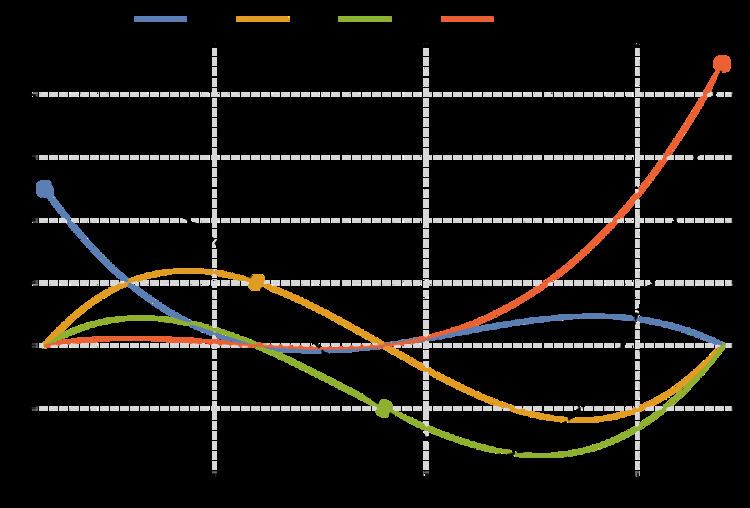 | ||
In numerical analysis, Lagrange polynomials are used for polynomial interpolation. For a given set of distinct points
Contents
- Definition
- Proof
- A perspective from linear algebra
- Example 1
- Example 2
- Notes
- Barycentric form
- Remainder in Lagrange interpolation formula
- First derivative
- Finite fields
- References
Although named after Joseph Louis Lagrange, who published it in 1795, the method was first discovered in 1779 by Edward Waring. It is also an easy consequence of a formula published in 1783 by Leonhard Euler.
Uses of Lagrange polynomials include the Newton–Cotes method of numerical integration and Shamir's secret sharing scheme in cryptography.
Lagrange interpolation is susceptible to Runge's phenomenon of large oscillation. And changing the points
Definition
Given a set of k + 1 data points
where no two
of Lagrange basis polynomials
where
For all
On the other hand,
In other words, all basis polynomials are zero at
It follows that
Proof
The function L(x) being sought is a polynomial in
Observe that:
- In
ℓ j ( x ) there are k factors in the product and each factor contains one x, so L(x) (which is a sum of these k-degree polynomials) must also be a k-degree polynomial. -
ℓ j ( x i ) = ∏ m = 0 , m ≠ j k x i − x m x j − x m
We consider what happens when this product is expanded. Because the product skips
-
ℓ j ( x i ) = δ j i = { 1 , if j = i 0 , if j ≠ i
where
Thus the function L(x) is a polynomial with degree at most k and where
Additionally, the interpolating polynomial is unique, as shown by the unisolvence theorem at the polynomial interpolation article.
A perspective from linear algebra
Solving an interpolation problem leads to a problem in linear algebra amounting to inversion of a matrix. Using a standard monomial basis for our interpolation polynomial
This construction is analogous to the Chinese Remainder Theorem. Instead of checking for remainders of integers modulo prime numbers, we are checking for remainders of polynomials when divided by linears.
Example 1
We wish to interpolate ƒ(x) = x2 over the range 1 ≤ x ≤ 3, given these three points:
The interpolating polynomial is:
Example 2
We wish to interpolate ƒ(x) = x3 over the range 1 ≤ x ≤ 3, given these three points:
The interpolating polynomial is:
Notes
The Lagrange form of the interpolation polynomial shows the linear character of polynomial interpolation and the uniqueness of the interpolation polynomial. Therefore, it is preferred in proofs and theoretical arguments. Uniqueness can also be seen from the invertibility of the Vandermonde matrix, due to the non-vanishing of the Vandermonde determinant.
But, as can be seen from the construction, each time a node xk changes, all Lagrange basis polynomials have to be recalculated. A better form of the interpolation polynomial for practical (or computational) purposes is the barycentric form of the Lagrange interpolation (see below) or Newton polynomials.
Lagrange and other interpolation at equally spaced points, as in the example above, yield a polynomial oscillating above and below the true function. This behaviour tends to grow with the number of points, leading to a divergence known as Runge's phenomenon; the problem may be eliminated by choosing interpolation points at Chebyshev nodes.
The Lagrange basis polynomials can be used in numerical integration to derive the Newton–Cotes formulas.
Barycentric form
Using
we can rewrite the Lagrange basis polynomials as
or, by defining the barycentric weights
we can simply write
which is commonly referred to as the first form of the barycentric interpolation formula.
The advantage of this representation is that the interpolation polynomial may now be evaluated as
which, if the weights
The barycentric interpolation formula can also easily be updated to incorporate a new node
We can further simplify the first form by first considering the barycentric interpolation of the constant function
Dividing
which is referred to as the second form or true form of the barycentric interpolation formula. This second form has the advantage that
Remainder in Lagrange interpolation formula
When interpolating a given function f by a polynomial of degree n at the nodes x0,...,xn we get the remainder
where
The remainder can be bound as
First derivative
The first derivative of the lagrange polynomial is given by
where
Finite fields
The Lagrange polynomial can also be computed in finite fields. This has applications in cryptography, such as in Shamir's Secret Sharing scheme.
